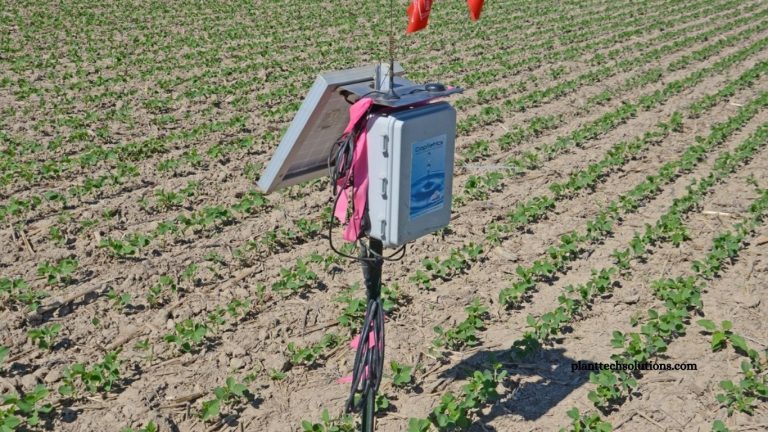Selecting the right soil sensor is crucial for maximizing crop health and improving farm productivity. With a variety of sensors available on the market ranging from moisture and nutrient monitors to pH and temperature detectors farmers often face the challenge of identifying which one suits their specific needs.
The ideal sensor depends on factors such as crop type, soil composition, field size, and the level of automation desired. Choosing the wrong sensor can lead to inaccurate data, wasted resources, and missed opportunities for optimizing yields. In this guide, we break down the key types of soil sensors, their benefits, and practical tips to help you determine which soil sensor is perfect for your farm.
Read More: Farming in a Changing Climate: The Role of Carbon Sequestration
Which Soil Moisture Sensor Should You Choose?
Deciding how to measure soil moisture can feel complicated, but METER’s plug-and-play soil sensors make it simple. All METER soil sensors provide research-grade accuracy and are minimally affected by salts (<10 dS/m bulk EC), temperature gradients, and soil texture.
Among the thousands of peer-reviewed publications using METER sensors, no single soil moisture or water potential (soil suction) sensor stands out as universally “best.” Instead, the right sensor depends on your specific needs and application.
Use the following considerations to help determine the ideal soil moisture or water potential sensor for your research. Explore the links for a deeper dive into soil moisture definitions, key terms, and related topics.

How to Measure Soil Moisture—Choose the Right Measurement
Volumetric Water Content
If your goal is to track the rise and fall of water in the soil, a soil moisture sensor (water content sensor) is essential. Soil is composed of water, air, minerals, organic matter, and sometimes ice. Water makes up a percentage of the total soil volume.
Water content can be measured gravimetrically by comparing the mass of water to the total mass of soil—but this method is labor-intensive. Most researchers prefer automated, volume-based measurements called Volumetric Water Content (VWC).
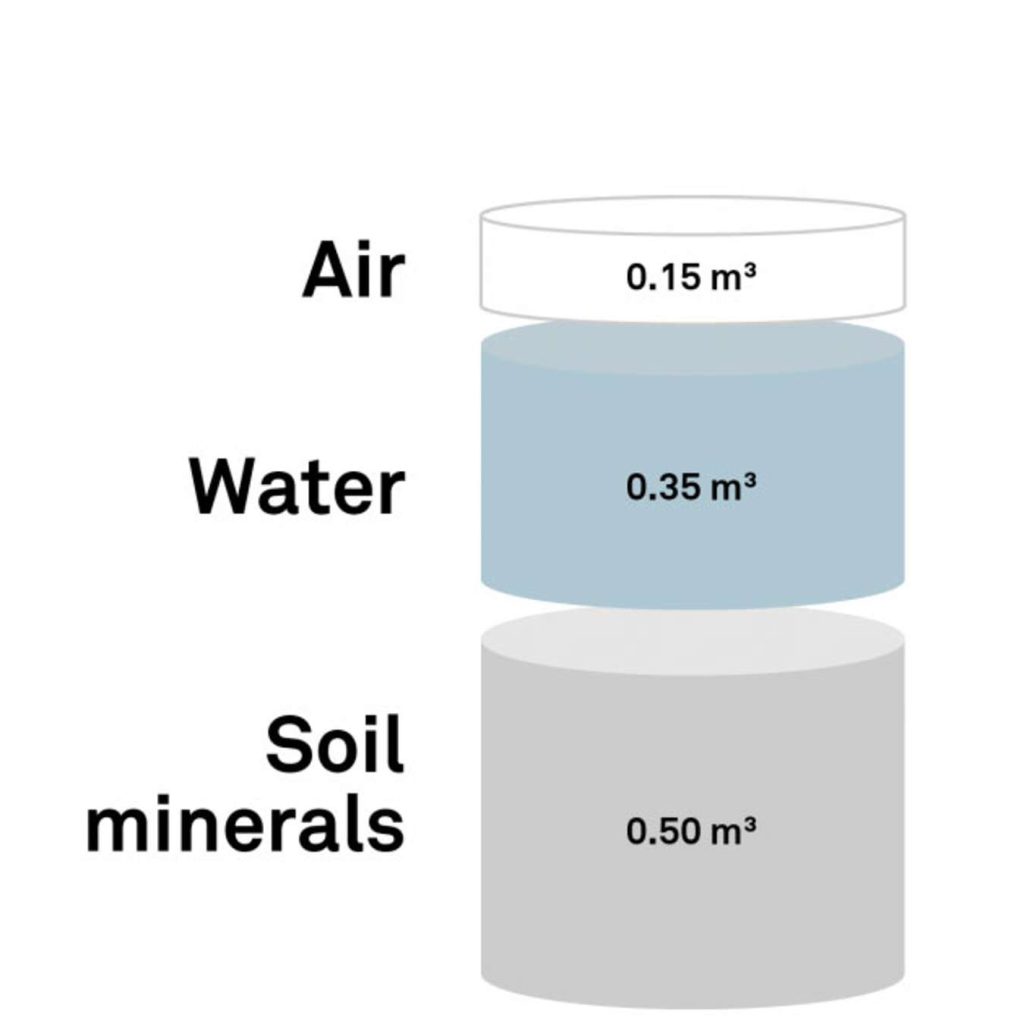
METER soil moisture sensors use high-frequency capacitance technology to measure VWC, assessing the amount of water relative to the total soil volume. Applications include watershed characterization, irrigation scheduling, greenhouse and fertigation management, plant ecology, water balance studies, microbial ecology, plant disease forecasting, soil respiration, hydrology, and soil health monitoring. [Learn more about volumetric water content here.]
Water Potential
To understand plant-available water, plant water stress, or water movement, a water potential sensor is needed in addition to a soil moisture sensor. Water potential measures the energy state of water in soil—essentially, how tightly water is bound to soil particles.
This tension indicates whether water is available for plant uptake and helps determine water movement, which always flows from high to low potential. Researchers can use water potential to predict dynamics of water movement and assess plant water availability. [Learn more about water potential here.]
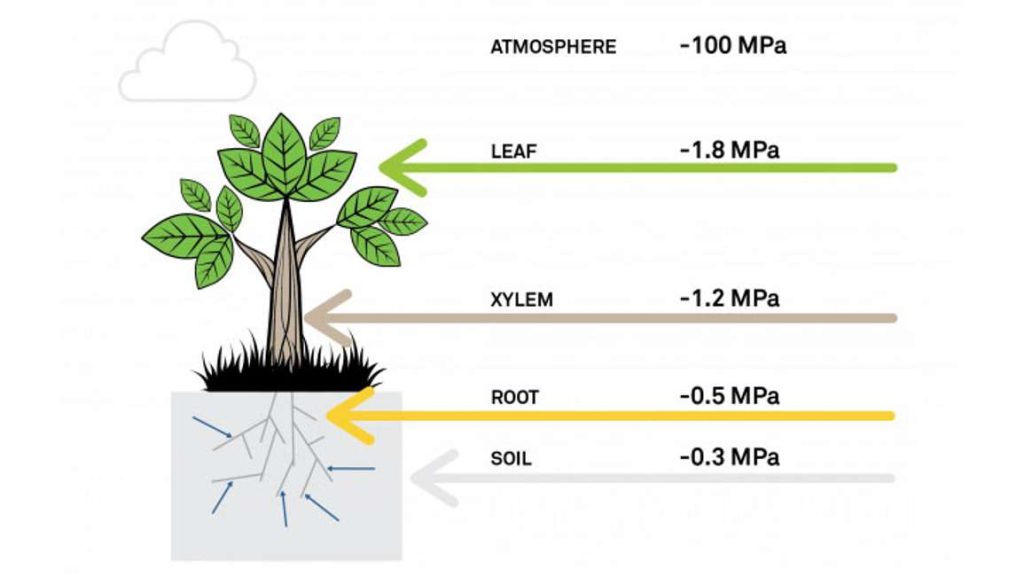
Understand your soil type and texture
In soil, the void spaces (pores) between soil particles can be simplistically thought of as a system of capillary tubes, with a diameter determined by the size of the associated particles and their spatial association. The smaller the size of those tubes, the more tightly water is held because of the surface association.
Clay holds water more tightly than a sand at the same water content because clay contains smaller pores and thus has more surface area for the water to bind to. But even sand can eventually dry to a point where there is only a thin film of water on its surfaces, and water will be bound tightly. In principle, the closer water is to a surface, the tighter it will be bound. Because water is loosely bound in a sandy soil, the amount of water will deplete and replenish quickly. Clay soils hold water so tightly that water movement is slow. However, there is still available water.
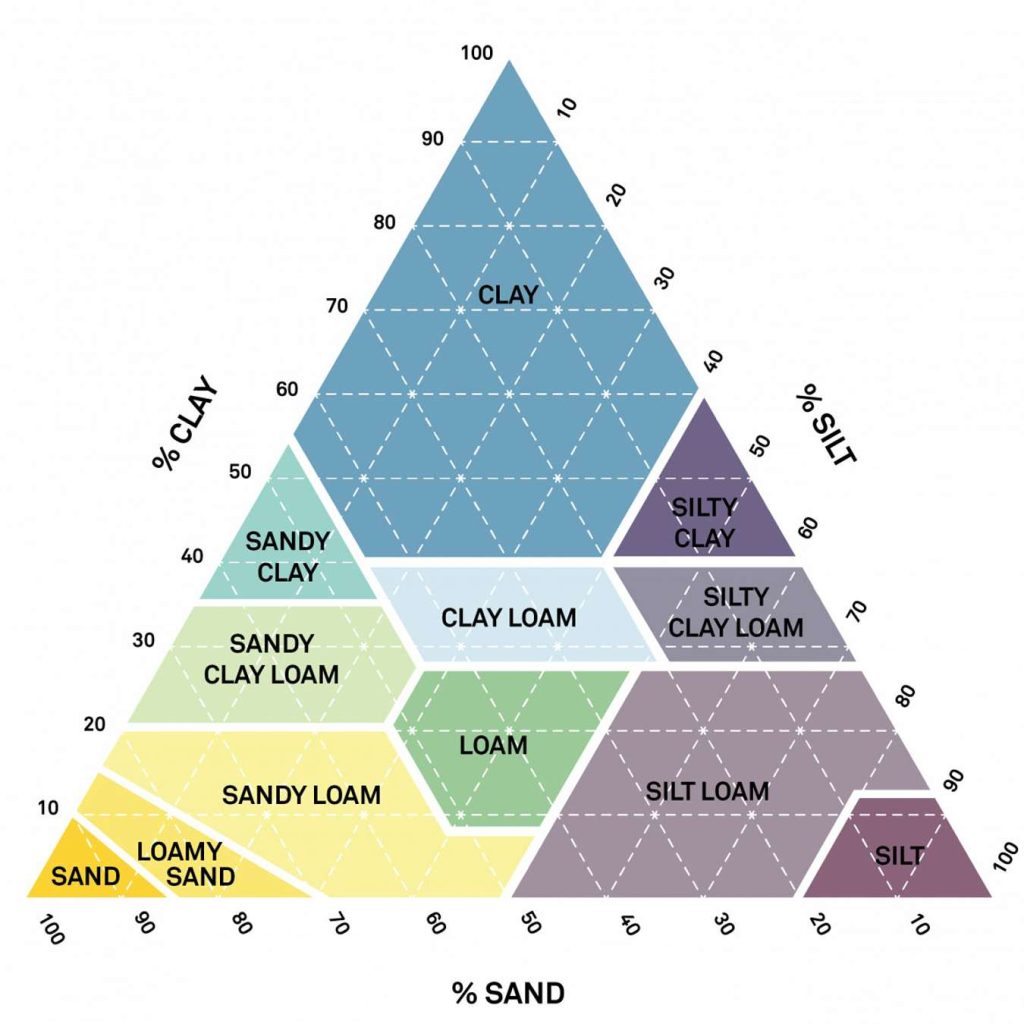
Two Measurements Are Better Than One
Soil moisture sensors effectively measure the percentage of water in all soil types and textures. However, using both types of sensors—a soil moisture sensor and a water potential sensor—provides a complete picture of soil water status.
Dual measurements allow researchers to determine not only how much water is present but also when and how much to irrigate. Soil moisture data reveal subtle daily changes caused by plant water uptake and indicate the amount of water needed to maintain the root zone at optimal levels. Meanwhile, water potential measurements define what that optimal level is for a specific soil type and texture.
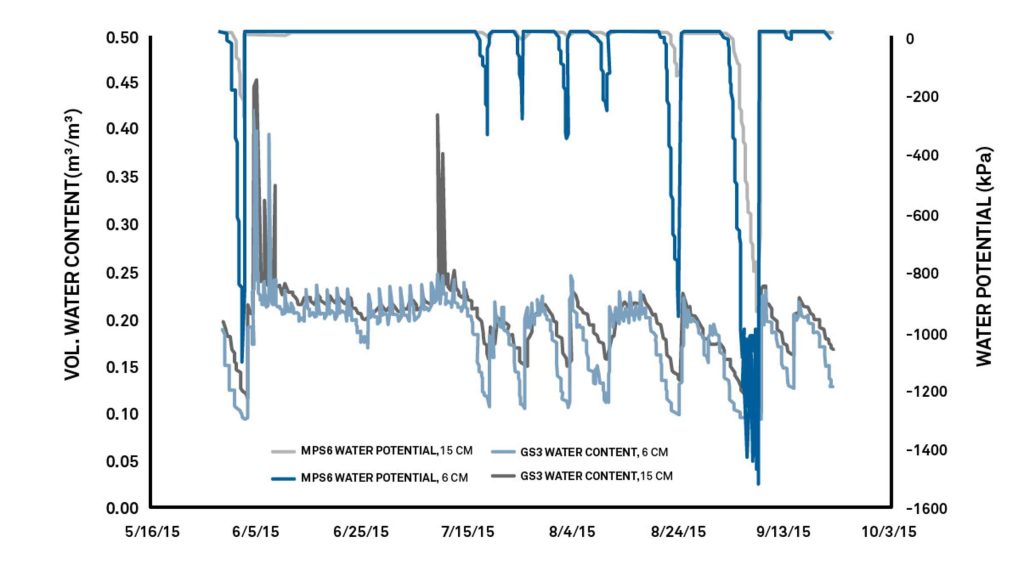
Get the Big Picture with Moisture Release Curves
Using both soil moisture and water potential measurements allows researchers to create in situ soil moisture release curves (also called soil water characteristic curves). These curves show the relationship between water content and water potential, providing a detailed view of soil water dynamics.
Scientists and engineers can analyze these curves in the lab or in the field to understand key soil properties, including hydraulic conductivity, total water availability, and how water moves through different soil types.
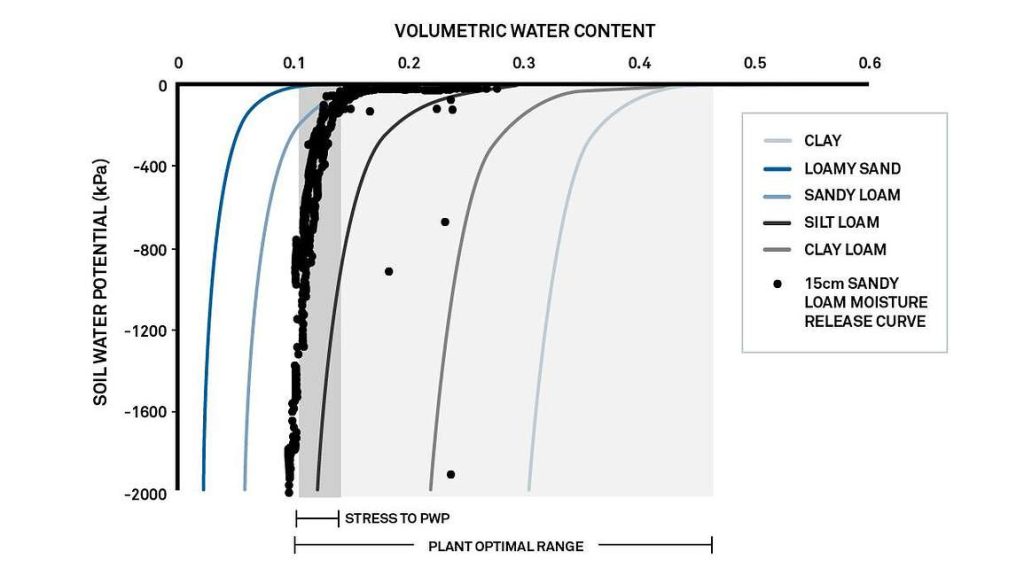
Choose the Right Soil Moisture Sensor
Life Expectancy Matters
When selecting a soil moisture sensor, it’s important to consider how long your experiment will run to ensure the sensor meets your needs.
METER’s 10HS and EC-5 sensors feature overmolding technology, lasting approximately 3–5 years under typical field conditions (shorter in warm, wet environments). For longer-term studies, the ruggedized TEROS 11, TEROS 12, TEROS 10, and TEROS 54 sensors are designed to last twice as long thanks to an upgraded polyurethane/epoxy fill. Lab tests indicate these sensors can function for 10+ years before water intrusion reaches the circuit board.
If your research takes place in tropical or consistently wet environments, it’s best to choose a long-life sensor to ensure durability and reliable data collection.
Which Sensor for What Purpose?
METER’s soil moisture sensors are designed with minimal sensitivity to temperature, but shallow installations in exposed locations may still be affected by temperature fluctuations. The TEROS 11, TEROS 12, and TEROS 54 sensors include an onboard thermistor, allowing simultaneous measurement of soil moisture and temperature without the need for additional sensors. The TEROS 54 profile probe measures soil water content and temperature at multiple depths, maximizing the number of measurements per data logger port.
For researchers interested in bulk electrical conductivity (EC) along with water content, the TEROS 12 is ideal. It measures soil EC in response to salts and fertilizers, requiring good contact between the stainless steel electrodes and the soil.
For soil moisture only, the TEROS 10 is a popular choice easy to install, reliable, and cost-effective, especially for large projects requiring multiple sensors. In challenging soils (hard, rocky, potting soil, or soilless media), TEROS series sensors ensure proper soil contact and compensate for air gaps.
All METER soil moisture sensors are plug-and-play with METER data loggers and compatible with third-party loggers via SDI-12 protocol. For remote sites, the ZL6 logger simplifies data collection, or data can be downloaded manually.
Understanding Variability Can Be Difficult
Soil moisture can vary widely within a single study site due to differences in soil texture, vegetation type and cover, topography, precipitation, management practices, and soil hydraulic properties (how quickly water moves through the soil). To accurately capture this variability, researchers need to carefully plan the number and placement of sampling locations.
Measuring soil moisture at multiple depths helps scientists understand how water moves through the soil profile and how variability affects water availability. Large research areas or sites with high variability often require many soil moisture sensors.
For cost-effective coverage of a large network, the EC-5 or TEROS 10 sensors are excellent choices. The newer TEROS 11 and TEROS 12 sensors have a larger volume of influence (1 liter), which helps smooth out variability in measurements.
Installation Impacts Data
METER’s high-quality, research-grade sensors provide accurate data, but proper installation is critical to ensure reliability. All dielectric probes are most sensitive between their prongs, making full contact with the soil essential.
Loss of contact or soil compaction within the sensor’s measurement volume can lead to errors. Water ponding on the surface or flowing preferentially down probe installation holes can also distort readings. These factors highlight why needle shape, size, and durability are important, especially in challenging soils.
The new TEROS Borehole Installation Tool solves many of these problems by eliminating air gaps, minimizing soil disturbance, and preventing preferential flow.
In extremely rocky or hard soils, consider using the TEROS 21 water potential sensor. Water content can be derived from water potential using a soil moisture release curve, and the TEROS 21 can be backfilled or packed in. For difficult soils, our unanimous recommendation is to use TEROS 10, 11, or 12 sensors with the installation tool.
| Measures | TEROS 12: Volumetric water content, temperature, electrical conductivityTEROS 11: Volumetric water content, temperature | Volumetric water content, temperatureat six depths | Volumetric water content | Volumetric water content | Volumetric water content |
| Volume of Influence | 1010 mL | 351 cm3 per segment | 430 mL | 240 mL | 1320 mL |
| Measurement Output | Digital SDI-12 | Digital SDI-12 | Analog | Analog | Analog |
| Field Lifespan | 10+ years | 10+ years | 10+ years | 3-5 years* | 3-5 years* |
| Durability | Highest | Highest | Highest | Moderate | Moderate |
| Installation | Installation tool for high accuracy | Installation tool for high accuracy | Installation tool for high accuracy | Install by hand | Install by hand |
Need Higher Accuracy in Your Soil Moisture Sensor?
For higher accuracy, consider performing a soil-specific calibration. METER soil moisture sensors measure volumetric water content by assessing the soil’s dielectric constant, which is strongly influenced by water content.
However, not all soils have identical electrical properties. Variations in bulk density, mineralogy, texture, and salinity mean that the generic mineral calibration used in METER sensors provides approximately ±3–4% accuracy for most mineral soils and about ±5% for soilless growth substrates (e.g., potting soil, stone wool, coco coir).
Accuracy improves significantly up to ±1–2% when using a soil-specific calibration. METER recommends that users either perform their own calibration or take advantage of the Soil-Specific Calibration Service to achieve the most precise volumetric water content measurements.
Choose the Right Field Water Potential Sensor
Accurate water potential measurements depend on selecting the right instrument and using it correctly. Ideally, a single device would measure water potential across the entire wet-to-dry range, but in reality, different instruments are designed for specific ranges.
METER’s TEROS 21 matric potential sensor is ideal for measuring water potential within the plant-available water range—from field capacity to air-dry conditions. The TEROS 22 is similar but offers easier installation, requiring no trenching. Both sensors are capable of accurate measurements across the full range of wetness, including levels as dry as permanent wilting point.
For measurements in the wet range, where most water movement occurs, a tensiometer is preferable. Tensiometers are the only instruments capable of directly measuring high water potential ranges with high accuracy.
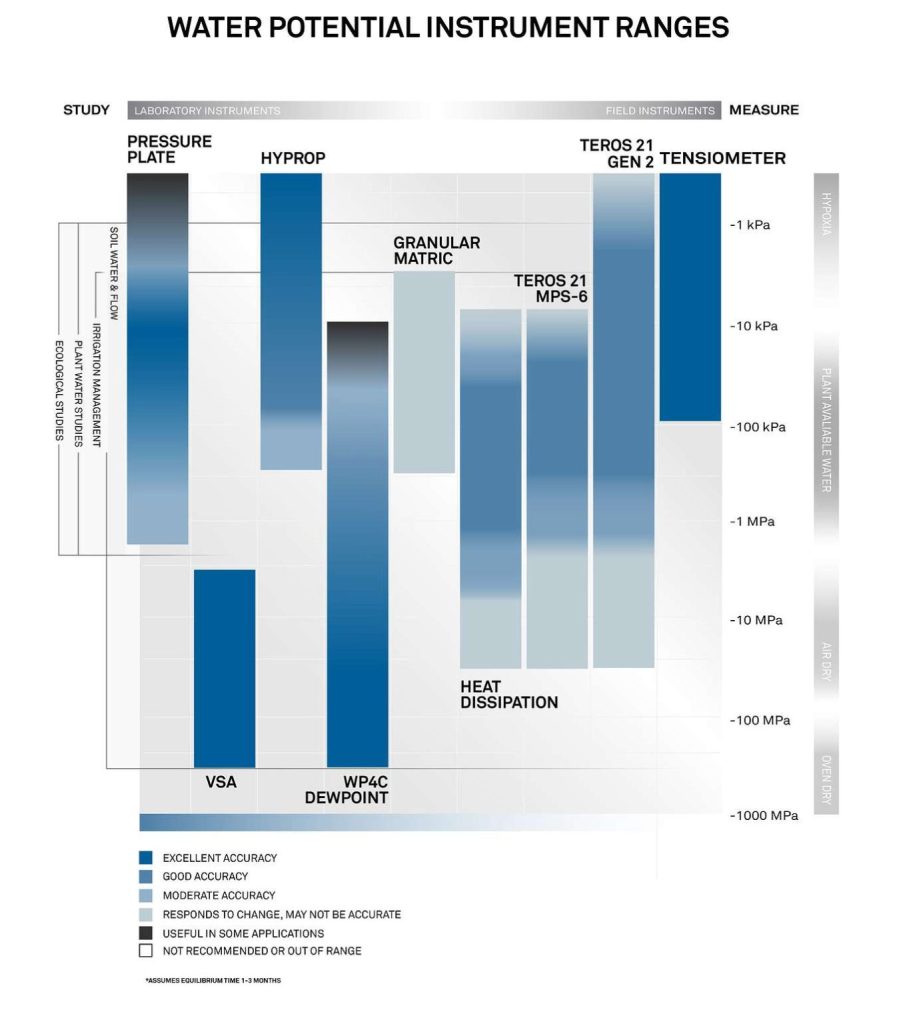
Matric Potential Sensors
METER’s TEROS 21 and TEROS 22 matric potential sensors consist of a moisture content sensor embedded in a porous substrate with a known moisture release curve. Once the porous material equilibrates with the surrounding soil, the moisture sensor measures the water content of the substrate, and the sensor uses the moisture release curve to convert this into water potential.
Range vs. Accuracy
The measurement range of a matric potential sensor depends on the variation in pore sizes within the porous substrate—the wider the range of pore sizes, the larger the measurement range. Commercial ceramics typically have uniform pore sizes, which limits range. The TEROS 21 and TEROS 22 use a ceramic designed with a wide pore size distribution to maximize measurement range.
However, accuracy depends on how well the moisture release curve characterizes the substrate. Greater variability in pore sizes can create inconsistencies from sensor to sensor, creating a trade-off between range and accuracy.
Calibration Solution
This challenge is addressed through factory calibration of each individual sensor. Traditionally, this process was time-consuming and expensive. The TEROS 21 and TEROS 22 achieve their research-grade accuracy with breakthrough automated factory calibration techniques, making them the first full-range, low-cost matric potential sensors suitable for precise scientific research.
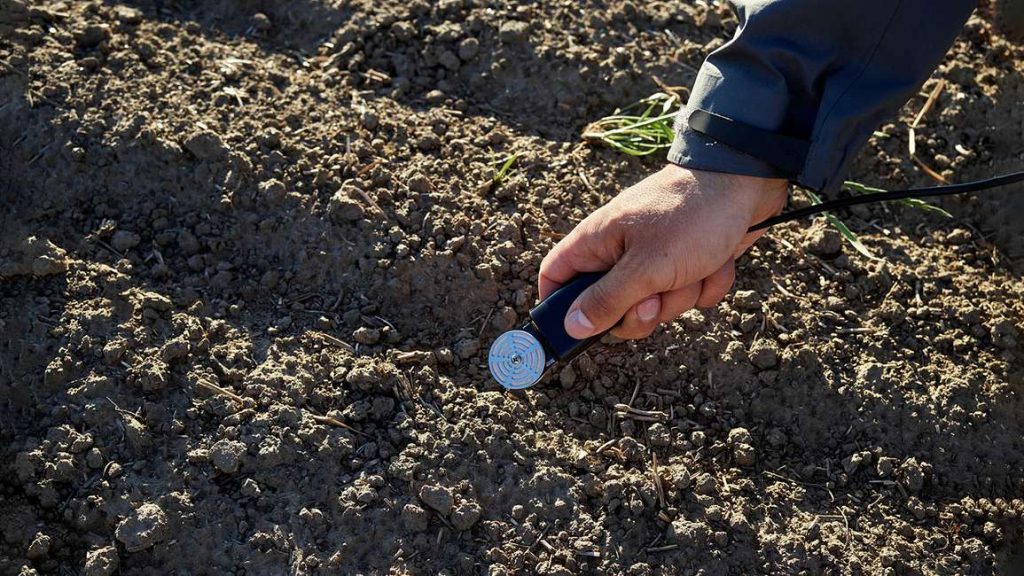
Tensiometers
Water potential measures the difference in potential energy between water in a soil sample and water in a reference pool of pure, free water. The tensiometer is a practical realization of this concept.
A tensiometer consists of a tube containing a reservoir of theoretically pure water, connected to the soil through a permeable membrane. Water moves from the reservoir to the soil until the energy is equal on both sides, creating a vacuum in the tube. A negative pressure gauge (pressure transducer) measures the strength of this vacuum, reporting water potential in terms of pressure.
Tensiometers are among the oldest water potential instruments, with origins dating back to Livingston in 1908, yet they remain highly useful. In the wet range, a well-constructed tensiometer provides excellent accuracy and is unaffected by soil heterogeneity.
The measurement range is limited by the ability of water in the tube to withstand a vacuum. Discontinuities such as grit or edges can trigger cavitation, which typically occurs around -80 kPa, near the middle of the plant-available range. METER’s tensiometers, crafted with precision German engineering and meticulous construction, extend this range to -85 kPa, offering exceptional accuracy for research applications.
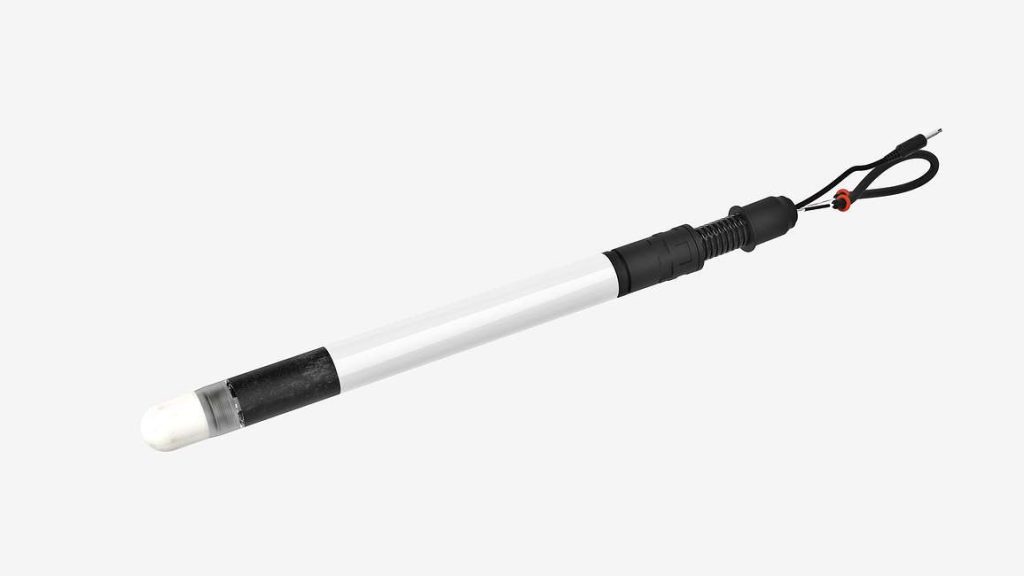
Which Tensiometer for What Purpose?
Choosing the right tensiometer depends on your application and data collection needs.
The TEROS 31 is a small laboratory tensiometer ideal for spot measurements or column experiments. While it can be used in the field for occasional spot checks, it requires laboratory refilling if cavitation occurs, which can be inconvenient.
The TEROS 32 is a field-ready tensiometer, equipped with external refilling tubes that eliminate the need to remove it from the ground. It provides continuous, near-real-time data remotely via ZENTRA Cloud and is designed for plug-and-play use with the ZL6 data logger and the ProCheck handheld reader, making it ideal for large sensor networks.
Both the TEROS 31 and TEROS 32 can interface with Campbell Scientific or similar data loggers, and both are compatible with the ZL6, ZENTRA Cloud, and ProCheck systems.
Understand Shaft, Cable, and Refill Tube Lengths
The TEROS 32 tensiometer is typically installed at an angle in the field. METER recommends using a field auger specifically sized for installing this tensiometer, along with an irrigation valve cover box to protect the shaft.
The shaft length depends on the desired installation depth. For example, if you want to measure at a 1-meter depth and are installing at an angle, the shaft should generally be 10–20 cm longer than the target depth to account for the angle.
Refill tubes must also be accessible. The deeper the tensiometer is buried, the longer the tubes need to be to reach the surface.
Finally, cable length should be determined based on the proximity to the data logger to ensure proper connection and reliable data collection.
TEROS 21 & TEROS 22 Matric Potential Sensors | TEROS 31 Tensiometer | TEROS 32 Tensiometer | |
|---|---|---|---|
| Cost | $$ | $$$ | $$ |
| Accuracy | ±(10% of reading + 2 kPa) from −100 to −5 kPa | ±0.15 kPa | ±0.15 kPa |
| Range | 0 to −100,000 kPa (1.70 to 6.00 pF) | –85 to +50 kPa (up to –150 kPa during boiling retardation) | –85 to +50 kPa |
| Power Requirements | 3.6-15 V, 10 mA | 3.6- to 28.0-VDC | 3.6- to 28.0-VDC |
| Measurement Output | Digital SDI-12 | DDI serial, SDI-12 communication protocol | DDI serial, SDI-12 communication protocol |
| Method Used for Determining Water Potential | Calibrated method: Capacitance of a ceramic matrix, six-point calibration | Direct method: Piezoelectric pressure sensor, Wheatstone full bridge | Direct method: Piezoelectric pressure sensor, Wheatstone full bridge |
| Data Logger Compatibility | ZL6 logger(and ZENTRA Cloud), EM60 loggers, Campbell Scientific | ZL6 logger(and ZENTRA Cloud), EM60 loggers, Campbell Scientific | ZL6 logger(and ZENTRA Cloud), EM60 loggers, Campbell Scientific |
| Best For… | – Long term research studies – Natural environment monitoring-TEROS 22 is the next gen versionof TEROS 21 with an easier installation (no trenching required) | – Column & spot measurements in the laboratory – Small point measurements | – Long term field studies – Vadose zone hydrology |
Frequently Asked Questions
Which soil moisture sensor is best for my research?
It depends on your application. For basic soil moisture measurements, TEROS 10 or EC-5 are cost-effective choices. For larger volumes, improved accuracy, or challenging soils, consider TEROS 11, 12, or 54. Dual measurements with a water potential sensor can provide a complete soil moisture profile.
Do I need a water potential sensor?
Yes, if you need to understand plant-available water, water stress, or water movement. Water potential sensors, like the TEROS 21 or 22, complement soil moisture sensors to provide the full picture.
What is the difference between TEROS 21 and TEROS 22?
Both measure matric potential across the full range of wetness. The TEROS 22 has simpler installation, requiring no trenching.
When should I use a tensiometer?
Tensiometers are ideal for measuring water potential in the wet range, where most water movement occurs. TEROS 31 is for lab or spot measurements, and TEROS 32 is designed for field use with real-time data collection.
How do I account for soil variability?
Measure soil moisture at multiple depths and locations. Large or heterogeneous sites may require more sensors. Sensors like TEROS 11 and 12 have a larger volume of influence to smooth variability.
How does installation affect sensor data?
Proper contact with the soil is critical. Avoid air gaps, compaction, ponding, or preferential flow paths. For difficult soils, use the TEROS Borehole Installation Tool.
Do I need a soil-specific calibration?
For higher accuracy, yes. Generic calibration yields ±3–5% accuracy, while soil-specific calibration improves accuracy to ±1–2%. METER offers a Soil-Specific Calibration Service for convenience.
Conclusion
Selecting the right soil moisture and water potential sensors is essential for accurate, reliable, and meaningful data in agricultural, ecological, or research settings. Understanding the differences between soil moisture, water potential, matric potential, and tensiometers allows researchers to match sensors to specific applications, soil types, and experimental goals.
Factors such as soil texture, variability, installation method, sensor lifespan, calibration, and data collection requirements all influence sensor performance and the quality of results.

